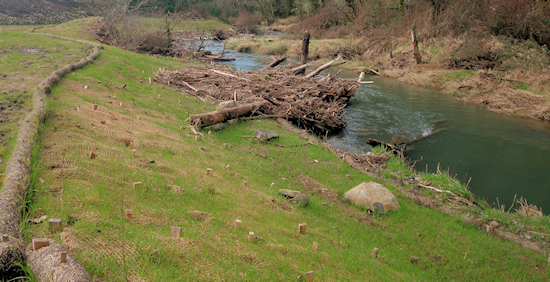Six Good Reasons to Plant Trees Beside a Stream

Saplings planted on the bank of Stout Creek will eventually grow to shade the stream and end up as the next generation of log jam habitat.
The strip of land beside your stream is a great place to plant trees. First of all, the 20 feet or so directly beside the stream probably isn’t practical to use for most other purposes. Second, the banks are too steep. Third, there will probably be seasonal flooding. Besides, a forested buffer zone along a stream is really beneficial.
The Benefits of Trees
It’s great habitat for wildlife and when large branches and leaves fall into the stream, it ends up being just what the doctor ordered for salmon and steelhead. Trees help you by reducing the risk of flooding and stabilizing the bank. In fact, there are six really very good reasons to plant trees stream side:
- They shade and cool the air and the stream water. It’s what they’re know for.
- Trees actually can clean the soil and the water percolating through it by absorbing chemicals and other pollutants. Scientists have studied how trees filter sewage and farm chemicals, reduce the harmful effects of concentrated animal wastes, and clean water runoff that enters streams.
- Trees slow storm water runoff and reduce the threat of flooding.
- Trees break the force of wind to help keep topsoil in place. Their roots bind the soil contributing to bank stabilization.
- Trees create oxygen. A mature tree produces as much oxygen in a growing season as 10 people inhale in a year. They also act as a giant filters cleaning the air we breath. Trees clean the air by intercepting airborne particles, reducing heat and absorbing pollutants such as carbon monoxide, sulfur dioxide and nitrogen dioxide.
- When they grow old and die, logs that have fallen into a stream will make great habitat for fish.
Actually a pretty good reason for trees, don’t you think?
